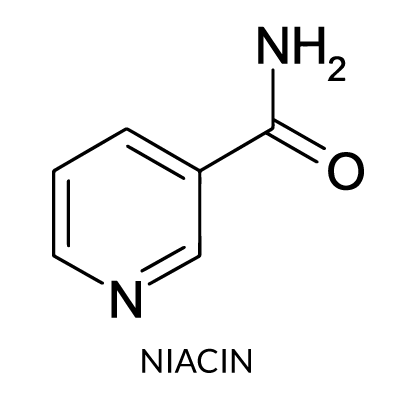Niacin is a water-soluble B vitamin, which is also known as vitamin B3 or nicotinic acid.
Nicotinamide is the derivative of niacin and used by the body to form the coenzymes nicotinamide adenine dinucleotide (NAD) and nicotinamide adenine dinucleotide phosphate (NADP). Nicotinic acid and nicotinamide are rapidly absorbed from the stomach and the intestine.
Causes of Niacin Deficiency
Niacin deficiency may result from inadequate dietary intake of niacin and/or tryptophan. Other nutrient deficiencies may also contribute to the development of niacin deficiency. When chicks hatch they have considerable tryptophan contained in the protein of the yolk, if it is fully absorbed. Chicks are at risk of niacin deficiency if the starter feed contains low levels of the amino acid, tryptophan or niacin. Most chicken corn-based chicken feeds provide limited levels of tryptophan.
Niacin Deficiency in Chickens
Niacin deficiency in young chicks most commonly presents as enlargement of the hock joint, bowing of the legs similar to perosis, poor feathering, and a dermatitis on the feet and head. Niacin deficiency in adult chickens presents as severe metabolic disorders in the skin and digestive organs. Clinical signs include loss of appetite, weakness, digestive disorders and diarrhea.
Dietary Sources of Niacin
Niacin is widely distributed in feedstuffs of both plant and animal origin. The best food sources of niacin include distiller’s grains, Brewer's yeast, beets, fish, various distillation and fermentation solubles, sunflower seeds, and certain oilseed meals. The availability of niacin in grain and grain by-products is very low.
Other sources of niacin include tablets or capsules in both regular and timed-release forms.
Nutritional Requirements of Niacin
The NRC (1994) recommends from 10 to 65 mg/kg of niacin (4.5 to 29.5 mg/lb) in feed for various classes of poultry, however this is suspected to be outdated, and more recent studies have shown that chickens should receive the following recommended amounts of niacin in their diet:
| Age/Life Stage | mg/kg |
|---|
| Newly Hatched Chicks (0 - 10 wks) | 50-60 |
| Young & Growing (10 - 20 wks) | 30-60 |
| Laying hens (Actively laying eggs) | 30-50 |
| Breeders (20 wks & older)* | 45-60 |
| Broiler/'Meat' Breed Chicks (0-18 wks) | 30-60 |
| Broiler/'Meat' Breeds* (19 wks & older) | 50-60 |
In the calculation of the niacin content of formulated diets, probably all the niacin from cereal grain sources should be ignored or at least given a value no greater than one-third of the total niacin. The bioavailability of niacin depends on the predominate grain source used in the feed. Soybean meal provides 100% bioavailability of niacin, while wheat, sorghum, and corn vary from 0 to 30%. In addition, different strains of chickens have different niacin requirements. Rapidly growing broiler chicks require more niacin because of the faster gains of modern strains of birds as compared with more historical populations.


